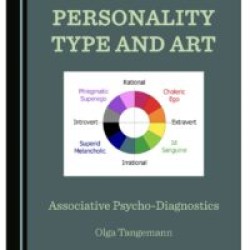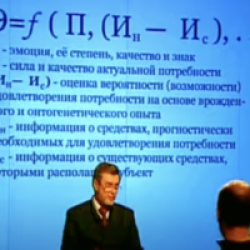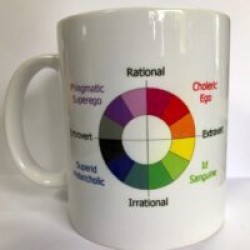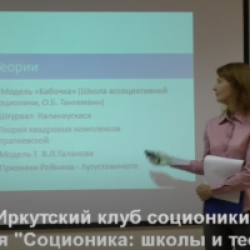Saying that I did not yet wrote any critical articles I decided to correct the error and summarise my thoughts. Recently we had an opportunity to watch the interview of Victor Gulenko, where he answered a few questions from English speaking socionists related to his view of Socionics in general but mainly talking about his theoretical approach. I think this is a very positive step forward as we can learn more information quicker and being able to find the answers to the questions which we are interested in.
I found interview interesting and useful as I also found some answers related to the humanitarian theory of socionics. However, in this article I wish to pin point certain arguments which I saw as being inconsistent or erroneous in my view. Therefore I would like to share my thoughts with you, dear reader. Here is the video of Victor Gulenko and the transcript of his answers provided by Elena Ames -Hagba(1).
1.50 – Elena speaks of DCNH –system as being validated (2). Recognized and popular – certainly but in a sense of scientific confirmation like statistics and the logical consistency definitely not. I thought it is important to mention because no concept is valid in socionics in scientific terms. We can only speak of popularity of the concepts. Later on in the interview to the questions of statistical proof Victor explains that he did not bother gathering statistics because his theory is a “living” theory of socionics.
2.12 Elena mentions 3 names of very popular soionists taking part in standardization of socionics theory. The influence could be a better word because standards in socionics are problematic. Socionics developed through years similar to psychanalysis which means that different schools have differences and sometimes significant in their theory and practice which is not a secret. Even though Elena mentioned that Victor is the second cited socionist I need to state that his approach, model G, for example, is way too different from the original theory of Aushra and model A. Therefore I see the word of standardization as wrong and misleading in this context.
Further I will use the transcript of the translation from the English speaking socionics forum (1).
–Is type innate? If so, at what age does type become set and can be observed? If not, what affects one’s typing?
“The type is innate, but its energy and information are filled gradually. You can observe the type from the day the child is born…. How to observe the type: type is the stable psychological structure of the person, and it manifests itself via various reactions in our brain. Unfortunately, we don’t have such a device to research how our brain works. We don’t have some kind of constant attached X-ray to our brains to monitor such spontaneous reactions, so you can instead observe the behavior of the person to detect the type. This is also how you can detect a type: you divide a group into two groups. For example extroverts and introverts and you give them the same task. Distantly you observe the differences of task implementation. Only with this contrast you can see the difference clearly”.
The author proposes to conduct an experiment to track the differences between the types. I do not see the need for it. We all know that the types differ in the typological features and these differences can be traced back in a more convenient way for the diagnostician, namely, during the interview, when filling out questionnaires and tests. I don’t expect diagnosticians to type clients by observation of their conduct in the performance of practical tasks and even in the group.
– How do you take mental illness into account when typing a person? What types are more susceptible for certain disorder? Is it possible for a severe mental illness or a traumatic event to change someone’s type? What about substance abuse and typing?
“Type does not change throughout your life, whether disorders, stress, or diseases. All that can change is the version of the type or the functional condition. Meaning some functions can get suppressed or others strengthened. If these changes are permanent and noticeable in you, it just means your subtype has changed. This subtype change can happen in one of two ways. The first way is called upgrade. It is when you go to the higher level of the psychological step. For example, if you are normalizing subtype you will become creative. The second way is called downgrade, which is when you go to the lower level of the psychological step, so if you are normalizing you will become harmonizing. In the first situation normalizing subtype will go above and beyond breaking norms, and in the second scenario, normalizing will be suppressing those norms to adapt to the situation”.
I found interesting how Victor explains changes in psychological states due to the accents on different functions because I also consider those changes but from a different perspective of psychodynamics. I called it psychological imbalance which is associated with unusual distribution of psychic energy in the psyche of the person. However I am a bit uncomfortable with idea of psychological upgrade and downgrade referring to different subtypes. Some subtypes are considered as higher (Creative) and some as lower (Harmonising) psychological level. This is the ethically acceptable way to differentiate between group qualities. For example, while making a diagnose I refer to psychological imbalance which can occur on the basis of any changes in psychodynamic profile and subtypes. (3)
“With over 30 years of experience of observing different types from different angles, it has become clear that the central quadras that are Beta and Gamma have more tendency to substance abuse. This is because these quadras value extroverted sensing, which produces an inclination towards tough competition. These types sometimes need some sort of stimulant or substance to tolerate those raised loads on their psyche of competition survival.”
As there is no statistics I cannot say that this suggestion makes sense for me based on my experience.
-How does The Big 5 relate to neuroticism index?
“The basic scale of The Big 5 can relate to socionics, as there are a lot of similiarities. The first factor is extroversion, which correlates to socionics extroversion. It is the first noticeable, “on the surface” trait. The second factor is openness, which is when a person is open to new things, which correlates to socionics intuition. The third factor is conscientiousness, which relates to socionics rationality. The fourth factor is agreeableness, which means that you will agree with society’s standards, which correlates with socionics ethics, especially ethics of relationships, which is introverted feeling. The last factor is emotional stability, which was discovered later. It doesn’t relate to Aushra or Jung’s dichotomies, but Gulenko discovered that it could relate to a DCNH subtype dichotomy called terminality. It is is about how well you adapt emotionally, and see your goals through to the end without being swayed emotionally.”
Conscientiousness is unlikely to be a typological trait . It may belong to some degree to Normalising subtype which is Superego-type quality in associative socionics but only in very general terms.
As regards to connection between emotional stability and terminality I would like to point to your attention that the original definition of terminality – initiation dichotomy sounds different. There is no reference to emotionality what so ever and Gulenko is stating that this is only specification of the usual dichotomy of rationality -irrationality. Therefore two traits of Big 5 are linked by Gulenko with rationality :
“I understand terminality as the ability to finish what you started and and a tendency towards regulation. Initiating – on the opposite is the ability to initiate, easy to switch and corresponding disorder in things and affairs. As you can see, this specification of the usual dichotomy rationality / irrationality. It would be wrong to think that any rational house is order, and it clearly plans, and all irrationals throw things and burdened by planning. “ (2).
-Does socionics consider individual human characteristics or only model ones?
“Yes, it does consider individual characteristics of the human being through the functional profile. It shows what functions are stronger and which are weaker in the person, in comparison to standard type, giving a close-up view of the individual person, and not just the type.”
Is this actual individual human characteristics? In my view this is the version of subtype-system on the functional level. It depends on what we mean by individual human characteristics. There are qualities which are not embraced by typology because typology means common features on different levels.
-What are the most reliable population statistics you have found? Is there a statistic broken down by quadra and type, and what is your favorite subtype system and why?
“Gulenko doesn’t collect statistics, so he can’t quote them, but he knows some people who work with the statistics and he will speak of this later on. Gulenko always gravitated towards live socionics and not the numbers. As an explorer of nature, he researched real behaviors of people and theoretically collected what he found out, and that is why his school is called School of Humanitarian Socionics…..”
It shows that Gulenko did not bother with statistical evidence of any sort which makes his approach psychoanalytical and philosophical in nature and not scientific. Not many socionists ever bothered to collect statistics and I myself just started to do something about it. Why is this a common case in socionics? For a few reasons and the main one is that at the basis of socionics lays psychoanalysis and method of interpretation. That is why the doctors of socionics are doctors of philosophy. Tests as tools of statistics collection were never in favour among socionists and while not understanding the nature of how tests work socionists managed to convince the public that tests are useless. At the same time they all were convinced that socionics is a science based purely on observation and interpretation.
No need to say that this means that all trust is in expert, paid consultancy and paid study. This is how socionics got alienated from science, from objective methods of scientific evidence and became the so called “expert-science”. While socionics tests exist the experts ignore their results and the clients are discouraged to do tests. The experts commonly do not trust self – typing of their clients . This is common practice. Everything in socionics works for the authority of the expert.
However, in the socionics media from time to time appear evidence that the experts’ opinion can widely differ when they type the same person. There is no gain to go through the chain of different consultants but money loss. This showed the recent “experiment “ of Sergey Smirnov, a businessman, who has been typed by more than 30 socionists. His personal experience of going through a chain of interviews he described in the article “Personal opinion about 30+ typings”. (4) Until socionists will not change their attitude towards using objective measures and methods of human sciences socionics will stay in the realm of psychoanalysis and philosophy but not science.
“…The first subtype system was proposed by Gulenko at the end of the 1980s, when socionics was in its infancy. He then only had two subtypes: initial and terminal, and not four like he uses today. The reason for creating four subtypes, is because Gulenko wanted to figure out more differences among the same type, after noticing that four people can be the same sociotype, but still different. After more research and work, Gulenko discovered that two additional attributes could be found within one type, and now he uses a four subtype system called DNCH, which stands for Dominant, Creative, Normalizing, and Harmonizing. The reason Gulenko came up with Normalizing and Harmonizing, is because he discovered a subtype dichotomy of contact and distance.”
Another popular socionist Semen Churumov explained what it means differentiating subtypes on the basis of the dichotomy of terminality – initiality in his notes about the theory of subtypes. (5) S. Churumov refers to the differentiation of subtypes by the two strongest functions known as program and creative function in Model A. One of the functions is always rational (terminal) and another irrational (initial).
Now is the time to look on the meaning of two other “newly discovered” By Gulenko dichotomies in order to understand how much they change our perception of the old existing dichotomies:
“The first polarity: contact / distance. The first pole is the predominance of the need for communication, and the second – the need to maintain distance. In the category of “contact” people fall pronounced extroverts and extroverted introverts. Distant will be accordingly pronounced introverts, but also avoiding intensive contacts introverted extroverts. Scale vertness thus split into four internal graduation….
And third, the added polarity – connecting / ignoring. The basis of the scale is sensitivity to changes in the environment. Connectors are very sensitive to such changes, and ignorers, as the name suggests, can not pay attention to it. This polarity is a subtype refinement of the classic dichotomy of dynamic / static.” (2)
The “new discovered” dichotomies by Gulenko are replica of the existing once. Whichever dichotomies you use you (new or old) you will end up with the same result. DCNH describes the 4 existing small groups of typology which lay on the crossing of 3 basic dichotomies extraversion- introversion, rationality – irrationality and statics – dynamics. He created a new definition of 4 existing groups of types but conceptualised them as subtypes. And as soon as he did that he blurred the boundaries between type and subtype because the criteria for detecting these groups did not change. Not many socionists at the moment understand this huge problem which Gulenko’s subtype system created for type diagnostics. Unfortunately.
According to Gulenko what you see is not what you get that means firstly you see the subtype. This reminds me of the MBTI model which states that introverts usually show their second and extraverted function. This principle in MBTI model interpretation created a confusion between two typologies and thanks to this subjective insight of the author we believe that judging – perception dichotomy for introverts is inverted.
At school of associative socionics we detect subtypes on the basis of associative tests and non-verbal preferences. Observation does not provide sufficient evidence for suggesting neither type no subtype, while associative tests easily cope with this problem. (6)
——————————————————————————————————————————————————————————————–
There are two approaches which allow us to consider subtype systems in socionics without blurring the boundaries between type and subtype.
1. We can use any system which is substantially different in definition of the groups and in the criteria. As an example could serve any other personality typology like enneagram. The principle of qualitative difference.
2. We can use the same system for types and subtypes. In this case we differentiate between type and subtype by the quantitative principle: which aspect is stronger or weaker. It can be functional level or dichotomy level.
What we should not do is to create a “mix and match”– approach where we mix and match both principles quantitative and qualitative and use the criteria which is essentially the same for defining type and subtype.
For example, to mix the type (the functional level) with the subtype (dichotomy level): type LII and subtype intuitive. Type LII belongs to intuitive types anyway. But if we suggest for LII the intuition being stronger than could it be that we have mistyped him and he is ILE – logical subtype?
Another example: LII with the NT subtype “scientist”. This does not make sense because LII belongs to the club of scientists anyway. If LII has LS – hard-core manager subtype we may wonder if he is actually NT or LS type?This is how mix and match sub-type system can bring the confusion into the process of diagnostics with no way of proof. Partly because the evaluation is heavily based on subjective observation and interpretation. The limitation of the usage of “mix and match” subtype system is that you need first to detect the type otherwise there is no meaning in detecting subtype what so ever.
—————————————————————————————————————————————————————————–
– How can you apply socionics for your personal growth? Can you improve any aspects of functions, and how? What functions have more potential for personal growth?
“Growth happens when you start interacting with others. … It is better not to touch your fourth function, because you will spend a lot of energy on it, but there won’t be any satisfaction brought back to you as a result. It is better to delegate that activity to somebody else.”
Gulenko recommends to improve the weak functions by interacting with the right people, which is a good advice. Alternatively you can do it yourself by practicing some of the methods and doing tasks the other people do as long as you know what is involved. Very often people to improve their Fi learn and teach Bible to others. As regards to 4th vulnerable function you can do it as well. As soon as you think it is better not to touch upon something you may limit yourself. People do successfully work using their 4th function. And the interest is always there naturally. Superego- functions in Model A remind the person to develop to acceptable level for the society. Also people use the functions not in isolation. You can use your program or role function while working on improving your 4th functions. It happens automatically in everyday life anyway.
-What is the basis of the energy model? And if there’s time, how do you distinguish between subtypes in your new subtype system?
“This is the most complex question, and requires a lot of knowledge in socionics. The basis of the socionics model is a system of aimed connections between psychological functions. They are chained together and always directed, because there is a transfer in a particular moment from one function into another in a certain direction. There are only two kinds of directed relationships between socionics objects, and they are asymmetrical. They are called supervision and benefit.
If we connect functions through supervision relationships, we will have Model A. Through supervision, the supervisee will receive the information quicker. It is an asymmetrical relationship.”
Why did Gulenko use the supervision and benefit as a basis to build the argument for his Energy model?(7) Because he liked the idea of “directed relationships” between the functions and by this he meant the idea of information and energy travelling like a chain reactions between 16 types. He also believes that supervision relationships are associated with the transfer of information and the benefit with energy. What other types of relationships may be transferring – information or energy – is not clear. However, the other IR can potentially be considered as a basis for the future models because all of them follow from model A. Aushra used absolutely different concept to create model A but this is a different story.
Victor should have considered carefully Aushra’s argument for building up model A in a first place. She would never accept this sort of explanation because for her informational metabolism and energy metabolism are essentially the same thing. She based her understanding of informational metabolism on the basis of energy metabolism. She stated very clearly that physical (energy) changes within the organism which she called “bodytacts” are reflected within the psyche by the corresponding functions: Ne – Fe – Se- Te. The changes in the body cause changes in the field (filedtacts) and these changes are reflected by the psyche as Ni- Ti-Si –Fi. She wrote that informational metabolism is simply the reflection of the energy metabolism in the psyche and they are two sides of reality. It was obvious for her that body-tacts and field-tacts are inseparable and as functions must be paired together in the model in order to give comprehensive information about the reality. That is why the socionics community is reluctant in accepting Model G as a valid alternative to Model A. (8)
“Gulenko’s practice shows that people will group themselves into triads or quads, according to their energy when they start solving a problem as a group, and not talking about the issue. Benefit relationships here play a big role. That’s how people connect to each other via energy, because they want to achieve something. That’s when energetic extroverts unite together, and the quiet introverts will be displaced. “
Gulenko suggests that different types will be attracted to each other on the basis of extraversion- introversion when they are problem solving. I do not see this argument as valid or supported by the experiments or statisitcs. Extraverts do attract introverts as much as logical types attract ethical and etc. I guess this dichotomy are emphasized due to the fact that it is related commonly to energy whether it is socionics or MBTI. (9) However, if we shall understand energy metabolism through this dichotomy we shall have very narrow and subjective view on the energy metabolism in general.
“The attribute of the extrovert and introvert dichotomy will play a role in this type of behaviour. For example, when a teacher asks a classroom a question, and everyone knows the answer, the first people to raise their hands will be the extroverts. This is how the division happens, through this simple example. This particular dichotomy is the basis of the energy model”.
This analogy only shows how extraverts differ from introverts but not explain how people group on the basis of extraversion- introversion while problem solving. And as far as I understood this is a key point for the concept of energy model.
“A very famous statistician, Talanov, performed an experiment by testing thousands of people through tests and questionnaires. He found out that people will show two strongest functions in their personality, which are both either introverted or extroverted. Although as we know, in socionics, in the first two functions one is extroverted and one is introverted. Statistics show the same results for your two weakest functions – they will be both either introverted or extroverted. This experiment shows that there are two types of functional models, the first one will be the informational model, which is what you use when you have to process something, and the second will be the energy model, which is what you use when you have to act and use energy for something.”
The name of the socionist is Victor Talanov. It really depends what functions Talanov found. It may well be the so called “support” for the Assocaitve model and TPE groups (10). The functions may reflect the division between the basic small groups of socionics typlolgy which are associated with functions both either extraverted or introverted. Talalnov has his onw model T and he may have a different interpretation of the results of his research all together. (11)
The vague example and reference to Talanov’s statistics means that Gulenko interpreted the results in favor to his concept. by the way, no test can provide evidence for any model. Model is a subjective tool of qualitative measure, which we call qualitative analysis. It can be used by a subject only. Tests measure something which can be measured in quantity that means dichotomies. Tests and experiments relate to one particular hypotheses and should not be interpreted by the wish of a researcher as a support of his psychoanalytical concept.
“To distinguish subtypes, of course you can use tests that include the additional dichotomies of initial/terminal and contact/distance.”
These dichotomies are just an update of existing irrational-rational and extraverted-introverted which we use for detecting the types. We can only use them simultaneously with the thought that the type must have a stronger presence in the psyche than subtypes and not otherwise. Regarding tests there is only one well known tests which measures not the type but sat the same time utilise the same criteria. FAP test stands for the functional accentuation behavior. According to K. Kravchenko, “FAP test determines the most superficial and dynamic part of personality – a functional profile, but sometimes you can see the deeper level of personality like sociotype and subtype if the type is “pure”. Functional Profile -is the picture of strength and weakness (relative to the” pure “type) of functions. It can change pretty quickly (say one year) when you change the environment, ie it is recorded strengthening or weakening of certain functions. “(12) According to this description, FAP does not determine the subtype. What kind of test means Gulenko when he says that we can detect subtype by tests remains a mystery.
“Another way of distinguishing these subtypes, is when you can compare this person to the 16 sociotypes as well as have an idea of each 4 subtypes in your head. This means you have to have 64 types in your head for reference. The best thing you can do, to distinguish subtypes, is to get 4 people of the same type in a room together, and ask them to solve a problem together. Through this working group, you will see the difference in their roles. If the group is stable, you will clearly see a leader – someone who takes charge, and this will be the dominant type. You will also clearly see someone who offers non-standard solutions, and starts generalizing ideas, this will be the creative type. You will also see someone who will make sure that everything is done, and that the group is not steering away from the normal, standard course, and this is the normalizing type. Lastly, will be someone who makes sure that communication is pleasant among the group. Remember, that all this is within one type.”
I wonder what will happen if you get 4 people of different types? Will you still be able to differentiate between the 4 subtypes?
These questions point to the dependence of this approach from the rigid specified conditions. If we imply rigid conditions, we are seeing the desired effect, simply because we see what we want to see. Once we go beyond these terms, the concept will not work – crumbles to dust.
What does this tell us? The DCNH approach of the detecting subtypes is not universal. We can expect that one and the same person, joining a new group of people may change his subtypes as he changes the roles while adapting to the new environment. If you are a dominant type and you find yourself are in a group with another dominant type, you may take on the role of the creative type or another.
Therefore, I conclude that detecting the subtype by the method proposed by V. Gulenko will not work as it will only show your adjusted role in the current circumstances. Circumstances will change and so will change your so called “subtype”. Associative approach is more versatile, as it allows to determine the subtype without rigid conditions and artificial restrictions. (13)
There is no means by which we can objectively establish the subtypes proposed by V.Gulenko. The main method suggested is observation. When we observe a person in real life situation we do not know whether we observe the feature of the type or subtype. We don’t know whether this is simply a role the person is playing due to the circumstances or this is his typical characteristic. To make suggestions on how subtypes may influence the work performance or intertype relationships we need first to be sure that we can objectively measure type and subtype as a stable quality and not a role change.
References.
1.Ames -Hagba E. Victor Gulenko Video Interview and Transcript https://www.youtube.com/watch?v=U4iJxIQt4hA http://www.the16types.info/vbulletin/showthread.php/47189-Victor-Gulenko-Video-Interview-and-Transcript
2. Gulenko V. theory of subtypes: DCNH system. http://socionics.kiev.ua/articles/types/sysdcnh/
3. Tangemann O.B. Psychodynamic profiele http://socionics4you.com/%d0%bf%d1%81%d0%b8%d1%85%d0%be%d0%b4%d0%b8%d0%bd%d0%b0%d0%bc%d0%b8%d1%87%d0%b5%d1%81%d0%ba%d0%b8%d0%b9-%d0%bf%d1%80%d0%be%d1%84%d0%b8%d0%bb%d1%8c/
4. Smirnov S. Typed by 35 different socionists. http://www.socioforum.su/viewtopic.php?f=782&t=58221&p=2108489#p2108489
5. Churyumov S. I. Reply to the topic about subtypes at the round table. http://socionics4you.com/%d1%82%d0%b8%d0%bf%d1%8b-%d0%b8-%d0%bf%d0%be%d0%b4%d1%82%d0%b8%d0%bf%d1%8b/
6. Associative tests. http://socionics4you.com/category/tests/
7. Gulenko V.V. Energymodel. http://uchoniyartist.blogspot.co.uk/2012/12/blog-post_18.html
8. А. Аugustinavichute. Socionics, Black squirrel, 2008, 78-81.
9. Типология Майерс-Бриггс. https://ru.wikipedia.org/wiki/%D0%A2%D0%B8%D0%BF%D0%BE%D0%BB%D0%BE%D0%B3%D0%B8%D1%8F_%D0%9C%D0%B0%D0%B9%D0%B5%D1%80%D1%81_%E2%80%94_%D0%91%D1%80%D0%B8%D0%B3%D0%B3%D1%81
10. Tangemann O.B. «Psychology and Socionics of Interpersonal Relationships». 2009, N1, p. 38 – 52.
11. Talanov V. Summary of the model “T”.http://www.socioniko.net/ru/articles/talan-modelt.html
12. Kravchenko K. FAQ for diagnosis in School of humanitarian socionics. http://uchoniyartist.blogspot.co.uk/2013/12/FAQ-SOCIODIAGNOSTICA.html
13. Tangemann O.B. Method of associative psychodiagnosis. http://socionics4you.com/%d0%b0%d1%81%d1%81%d0%be%d1%86%d0%b8%d0%b0%d1%82%d0%b8%d0%b2%d0%bd%d0%b0%d1%8f-%d0%bf%d1%81%d0%b8%d1%85%d0%be%d0%b4%d0%b8%d0%b0%d0%b3%d0%bd%d0%be%d1%81%d1%82%d0%b8%d0%ba%d0%b0-%d0%b0%d0%bf%d0%b4/










Recent comments